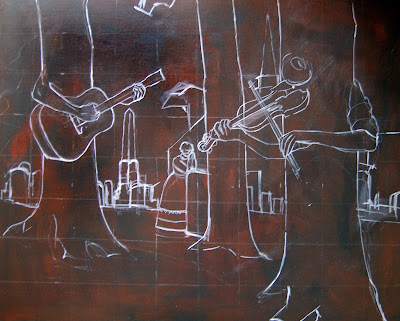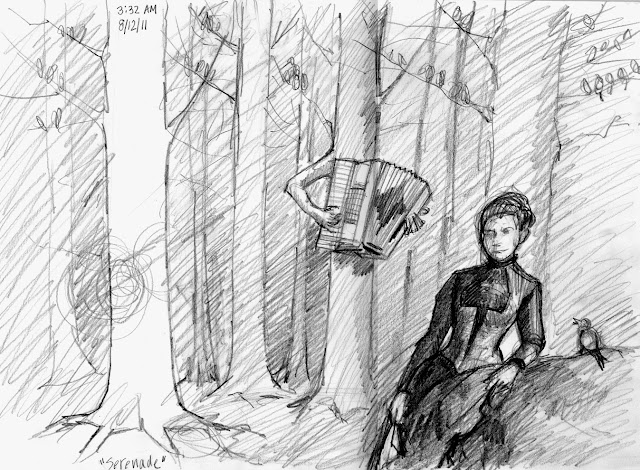 The trouble with painting is that once I start, it's very difficult to stop. If I didn't have dinner to make or keep to any sort of a schedule, I would surely spend the entire day still in my pajamas blissfully working on a piece of art. Sometimes I can arrange to work for long blocks of time and may even pull an all-nighter to finish a painting or meet a deadline. The process is so absorbing I hardly notice the passage of hours and can accomplish a great deal in one sitting.
The trouble with painting is that once I start, it's very difficult to stop. If I didn't have dinner to make or keep to any sort of a schedule, I would surely spend the entire day still in my pajamas blissfully working on a piece of art. Sometimes I can arrange to work for long blocks of time and may even pull an all-nighter to finish a painting or meet a deadline. The process is so absorbing I hardly notice the passage of hours and can accomplish a great deal in one sitting. My studio is located on the third floor of an old house that has withstood three major hurricanes and over a hundred years of everyday family life. An example of Queen Anne architecture, it was built when the trolley once ran from Providence into the Edgewood neighborhood of Cranston. It has a resident ghost, an elderly woman in a pink dress who appeared the day our family moved in. She likes her privacy, but I believe that she silently keeps me company while I work. To honor her, when we renovated the stairway up to the third floor we asked our carpenter to inlay a fragment of china picturing a lady wearing pink right into the woodwork.
My studio is located on the third floor of an old house that has withstood three major hurricanes and over a hundred years of everyday family life. An example of Queen Anne architecture, it was built when the trolley once ran from Providence into the Edgewood neighborhood of Cranston. It has a resident ghost, an elderly woman in a pink dress who appeared the day our family moved in. She likes her privacy, but I believe that she silently keeps me company while I work. To honor her, when we renovated the stairway up to the third floor we asked our carpenter to inlay a fragment of china picturing a lady wearing pink right into the woodwork.Two arched windows facing west and south offer views of the street, neighbors' houses, and some silver maple tree tops. It's quiet for the most part, and when I paint on my easel using the natural light from the west window I can observe everything happening on the sidewalk below.
I agree with Albert Einstein's opinion that a cluttered mind is better than an empty one and embrace that belief regarding my studio space. It has become a repository for all the interesting found objects, decorative materials, and vintage parts I've scored at flea markets, yard sales, consignment shops, and the curbside on the eve of trash pick up. Everything I collect is potentially useful and sooner or later becomes part of a piece of my artwork.
When it come to painting though, I try to keep things pretty neat. I use a disposable palette, torn up
t-shirts for rags, recycled plastic container tops to hold a small amount of Winsor & Newton Liquin Fine Detail gloss medium, Turpenoid odorless solvent in a lidded jar, and a variety of Rembrandt oil paints along with Permalba white. I enjoy working on a toned ground moving from dark to light.
When I began the musical tree painting, I used Photoshop Elements to create a white lined grid on the photo collage proportional to 24" x 30." I added an additional layer of gesso to a commercially prepared linen canvas of that same size and then coated it with a mixture of burnt umber, burnt sienna, and ultramarine blue acrylic paint. Once that had dried, I drew a matching actual size grid on the dark canvas with white charcoal pencil and transferred the composition using a fine brush and white acrylic paint.
At this point I began using oil paint and blocked in rough areas of color filling most of the canvas in one sitting. While the paint was still wet I refined shapes and enhanced some of the blocks of color.
At this point I began using oil paint and blocked in rough areas of color filling most of the canvas in one sitting. While the paint was still wet I refined shapes and enhanced some of the blocks of color.
 The effect of the dark ground peeking through "cracks" around small shapes of a lighter color created a convincing tree bark texture. While the paint was still wet I scratched repeatedly with a palette knife revealing more of the dark underpainting.
The effect of the dark ground peeking through "cracks" around small shapes of a lighter color created a convincing tree bark texture. While the paint was still wet I scratched repeatedly with a palette knife revealing more of the dark underpainting.
The next day or so after the paint had completely dried, I began to glaze objects with a mixture of Liquin, solvent, and a small amount of color. This unified areas of scumbling where paint of one color was lightly dragged over the surface leaving another color exposed beneath it.
Glazing with dark color can also be used to create the illusion of transparent shadows.
Leaves were then added to the background in tiny daubs of bright color and a splayed brush was used to imitate boughs of pine needles. The brush sacrificed its life for the painting.
I began refining objects and correcting my drawing, adding lights and then deepening them with glaze before adding more lights on top. Eventually the values struck the proper balance as amazing textures and unexpected color combinations evolved.
I spent a lot of time on the figure of the woman feeling as if I was painting one of those Victorian miniatures on ivory. Possibly because the face was so tiny, I struggled to get a resemblance to the original photo of Catherine. In the end the woman demanded her own identity, and although there is something of Catherine in her eyes, I decided to let her be and move on. As I continued to finish the painting, the plot for my story began to gel. She did not look happy to me and I came up with a reason why. I also decided that she wasn't the main character "Zadie." She was her mother and I decided to call her "Cora."With an end of the painting in sight and a plot of a story to start typing, I worked on finishing the arms of the musicians integrating their shoulders into the tree bark. I paid attention to the background and described a little better the gravestones and church steeple. A dark glaze on the landscape helped to deepen the shadows.
Remember that nice clean palette I started out with? This is what it usually looks like at the end of a day of painting. It's always a pleasure to be able to rip off the top sheet and start fresh again every morning.
With the deadline of a show the painting was to be exhibited in only a couple of days away, I chugged away making progress detailing the instruments, fleshing out the musicians' arms, continuing to add colored leaves, and texturing the tree bark.
After many hours of detail work, the painting, Serenade, was finally ready for me to sign my name and date it in the lower left corner. I stayed up all night finishing it in preparation for the Cambridge Art Association small group show "Process Explored" that was to be set up the following day. At 6:15 AM when the birds started singing and the sun came up, I popped it into a frame and started loading the car with the rest of my drawings and paintings for the trip to Cambridge.
Once my work was up in the gallery, it was time to go back home for some sleep and get ready for the opening. This is a photo of the five artists who participated in the show. It was a great opportunity to show my drawings and paintings at University Place in Cambridge, and wonderful to meet and work with this group of talented artists.
 |
| Janice Corkin Rudolf, Greg Spitzer, Nedret Andre, Brenda van der Beek, and Wendy Brusick |































